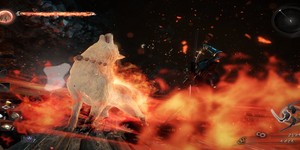
The added clarity to Dark Souls III isn't merely thematic, many of the game's older systems have been refined too. Titanite is far more common in DS III, and the world is scattered with elemental "gems", which makes upgrading weapons easier and infusing them with magical powers more straightforward. Creating powerful items from Great Souls is far simpler too - a case of taking an item to an NPC who will then effectively do the work for you. All the above tasks can be performed from Firelink, which is separated from the other environments, enabling you to do all your necessary upgrades at once in a place which is safely kept away from the rest of the world.
The downside of this is that Firelink sticks out as a break in an otherwise impressively fashioned chain. Dark Souls II's lack of worldly integrity was one of its biggest failings, but there are no such problems here. Each new area you encounter flows smoothly into the previous one, although there is less of the mazelike quality exhibited by Lordran. The move to the Bloodborne engine enables much wider open spaces, which Dark Souls III uses regularly. It also necessitates the return of the controversial bonfire teleporting, as Dark Souls III is an absolutely huge game. Importantly though, DS III blends this with the ingenious shortcuts of the first game, so the joy of navigating a long stretch of dungeon to open up a much more immediate route remains present.
The switch to the Bloodborne engine has two further implications for Dark Souls III. The first is its capacity to impress from a visual perspective. Dark Souls has always been a series with a love of dramatic views and stunning panoramas, and in this regard Dark Souls III does not disappoint. The first time I saw Irithyll of the Boreal Valley, the sight genuinely took my breath away. Moments later, the first enemy I encountered in Irithyll of the Boreal Valley literally took my character's breath away.
This is the other major change from the previous Dark Souls games; combat is slicker, faster, and more lethal than it has ever been. These alterations are clearly influenced by Miyazaki's work on Bloodborne. Emerging victorious from a fight in Dark Souls III requires a far more comprehensive understanding of the combat system. For example, I generally play as a Knight, and am always content to hide behind my shield whenever possible. Yet in DS III blocking costs far more stamina and many enemies have longer attack cycles, so learning to dodge reliably is crucial. At the same time, many enemies have attacks that are designed to thwart a serial roller, so knowing when to block at the right time is equally important.
I believe this is why From Software opened up the weapon upgrade system. Although it begins with a few fairly simple areas, Dark Souls III quickly ramps up the challenge, and by the halfway point will give even the most grizzled of Souls veterans a serious challenge. I lost an entire evening to Pontiff Sulyvahn - a mid-game boss who is noticeably tougher than those before him. Defeating him required several return trips to Firelink so I could lick my wounds and rethink my strategy, but allowing me to do that encouraged me to experiment in a way that previous Souls games did not.
There are some flaws. While for the most part the more explicit approach of Dark Souls III is a good thing, sometimes it hits a little too on the nose. From Software excel at creating enemy designs that evoke a kind of tragic horror that doesn't feel crass or exploitative, but there are some examples in DS III that do tread over this line. There's a mid-game enemy with a distinctly foetal quality about it that I found to be rather tasteless. Similarly, the writing can be too blunt, or overshoot the other way and descend into clumsy fantasy dialects.
The PC version also suffers from a few technical issues. While for the most part I enjoyed the smoothest Dark Souls experience I've had yet on PC, in some of the more visibly demanding areas the game began to struggle, and I'm running on a GTX Titan. The game also has a tendency to crash when using physics-heavy items, such as flowing coats or weapons with elemental effects. Upgrading my drivers fixed some of these crashes, but not all of them. Although these issues were annoying when they occurred, their appearance was uncommon, no more than three or four times during my playthrough.
All told, Dark Souls III is an absolutely enthralling experience. It clears up the more obtuse elements of the original, while also delivering a grander, slicker game with a smoother difficulty curve that remains utterly uncompromising in the latter stages. It is also a sequel that reflects on its own impossible position, doing it all it can to build upon the groundbreaking original, while admitting that it cannot break that same ground again. Hence while Dark Souls III may not ascend to the same dizzying heights, it does construct a castle where Dark Souls once climbed, and the results is as good a sequel as you are likely to get.
The downside of this is that Firelink sticks out as a break in an otherwise impressively fashioned chain. Dark Souls II's lack of worldly integrity was one of its biggest failings, but there are no such problems here. Each new area you encounter flows smoothly into the previous one, although there is less of the mazelike quality exhibited by Lordran. The move to the Bloodborne engine enables much wider open spaces, which Dark Souls III uses regularly. It also necessitates the return of the controversial bonfire teleporting, as Dark Souls III is an absolutely huge game. Importantly though, DS III blends this with the ingenious shortcuts of the first game, so the joy of navigating a long stretch of dungeon to open up a much more immediate route remains present.
The switch to the Bloodborne engine has two further implications for Dark Souls III. The first is its capacity to impress from a visual perspective. Dark Souls has always been a series with a love of dramatic views and stunning panoramas, and in this regard Dark Souls III does not disappoint. The first time I saw Irithyll of the Boreal Valley, the sight genuinely took my breath away. Moments later, the first enemy I encountered in Irithyll of the Boreal Valley literally took my character's breath away.
This is the other major change from the previous Dark Souls games; combat is slicker, faster, and more lethal than it has ever been. These alterations are clearly influenced by Miyazaki's work on Bloodborne. Emerging victorious from a fight in Dark Souls III requires a far more comprehensive understanding of the combat system. For example, I generally play as a Knight, and am always content to hide behind my shield whenever possible. Yet in DS III blocking costs far more stamina and many enemies have longer attack cycles, so learning to dodge reliably is crucial. At the same time, many enemies have attacks that are designed to thwart a serial roller, so knowing when to block at the right time is equally important.
I believe this is why From Software opened up the weapon upgrade system. Although it begins with a few fairly simple areas, Dark Souls III quickly ramps up the challenge, and by the halfway point will give even the most grizzled of Souls veterans a serious challenge. I lost an entire evening to Pontiff Sulyvahn - a mid-game boss who is noticeably tougher than those before him. Defeating him required several return trips to Firelink so I could lick my wounds and rethink my strategy, but allowing me to do that encouraged me to experiment in a way that previous Souls games did not.
There are some flaws. While for the most part the more explicit approach of Dark Souls III is a good thing, sometimes it hits a little too on the nose. From Software excel at creating enemy designs that evoke a kind of tragic horror that doesn't feel crass or exploitative, but there are some examples in DS III that do tread over this line. There's a mid-game enemy with a distinctly foetal quality about it that I found to be rather tasteless. Similarly, the writing can be too blunt, or overshoot the other way and descend into clumsy fantasy dialects.
The PC version also suffers from a few technical issues. While for the most part I enjoyed the smoothest Dark Souls experience I've had yet on PC, in some of the more visibly demanding areas the game began to struggle, and I'm running on a GTX Titan. The game also has a tendency to crash when using physics-heavy items, such as flowing coats or weapons with elemental effects. Upgrading my drivers fixed some of these crashes, but not all of them. Although these issues were annoying when they occurred, their appearance was uncommon, no more than three or four times during my playthrough.
All told, Dark Souls III is an absolutely enthralling experience. It clears up the more obtuse elements of the original, while also delivering a grander, slicker game with a smoother difficulty curve that remains utterly uncompromising in the latter stages. It is also a sequel that reflects on its own impossible position, doing it all it can to build upon the groundbreaking original, while admitting that it cannot break that same ground again. Hence while Dark Souls III may not ascend to the same dizzying heights, it does construct a castle where Dark Souls once climbed, and the results is as good a sequel as you are likely to get.


MSI MPG Velox 100R Chassis Review
October 14 2021 | 15:04

![Dark Souls III Review [ASAP] Dark Souls III Review](http://images.bit-tech.net/content_images/2016/04/dark-souls-iii-review/dsiii6-614x345.jpg)
![Dark Souls III Review [ASAP] Dark Souls III Review](http://images.bit-tech.net/content_images/2016/04/dark-souls-iii-review/dsiii7-614x345.jpg)
![Dark Souls III Review [ASAP] Dark Souls III Review](http://images.bit-tech.net/content_images/2016/04/dark-souls-iii-review/dsiii8-614x345.jpg)
![Dark Souls III Review [ASAP] Dark Souls III Review](http://images.bit-tech.net/content_images/2016/04/dark-souls-iii-review/dsiii9-614x345.jpg)
![Dark Souls III Review [ASAP] Dark Souls III Review](http://images.bit-tech.net/content_images/2016/04/dark-souls-iii-review/dsiii10-614x345.jpg)








Want to comment? Please log in.